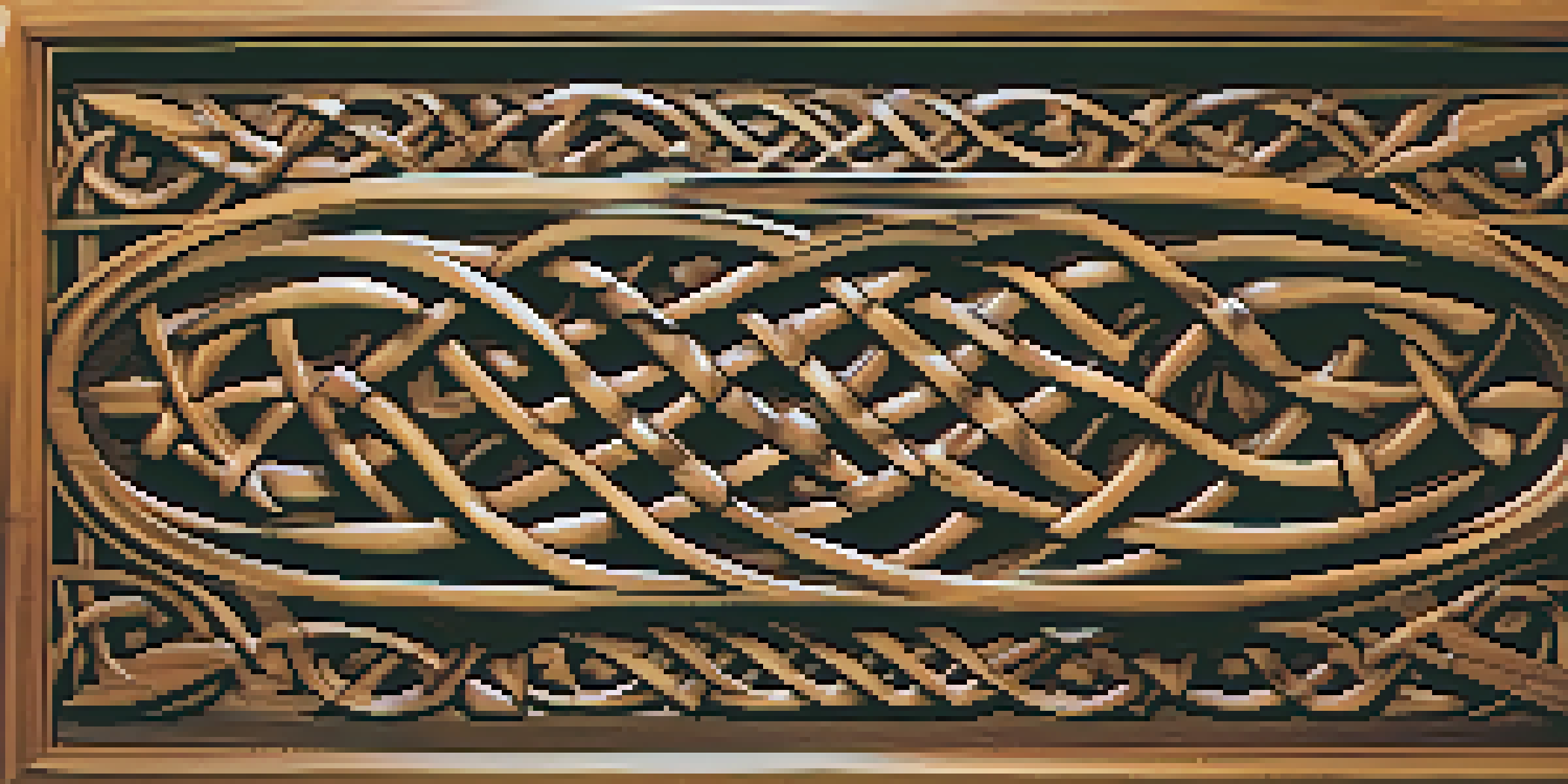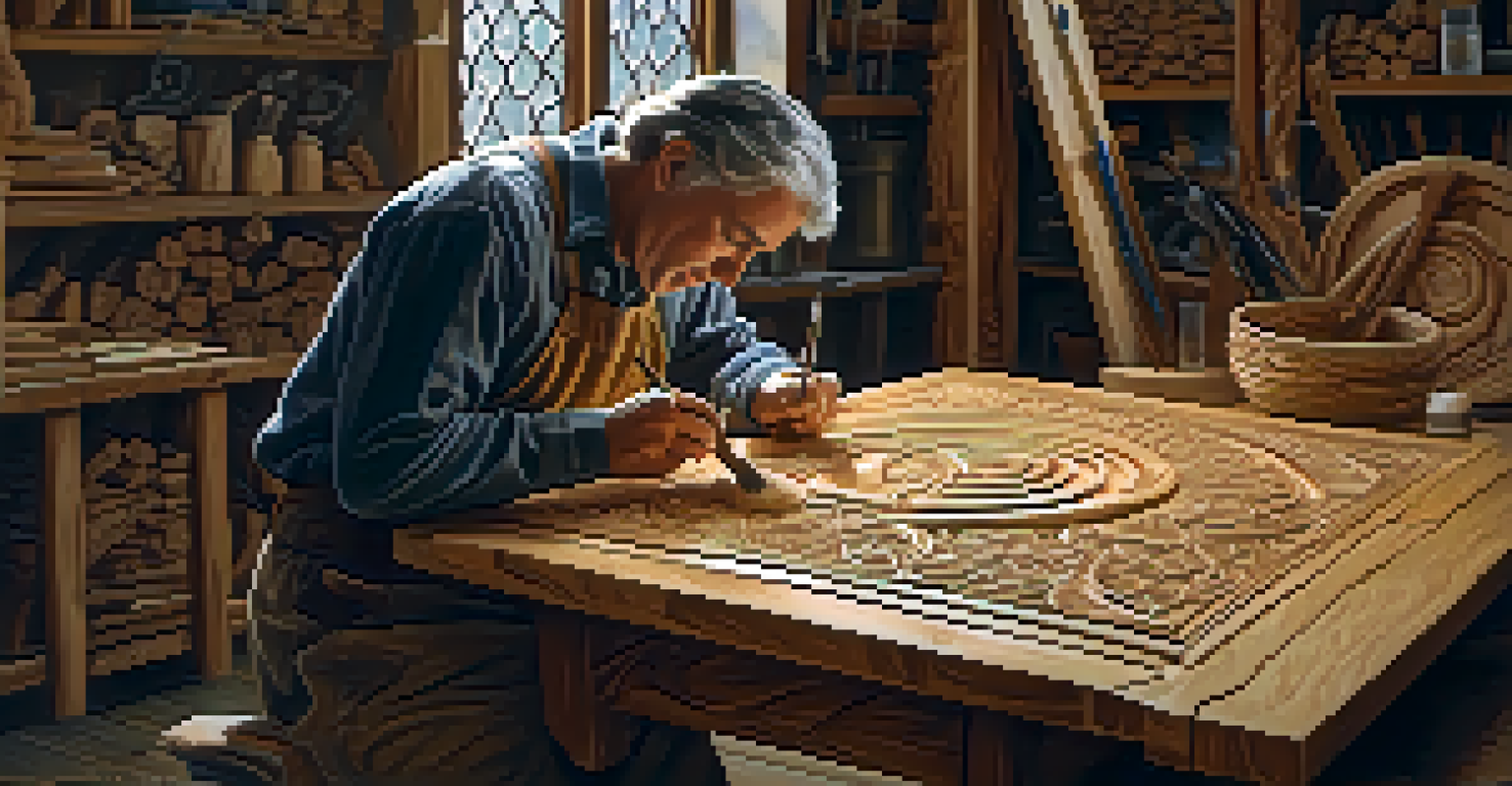Celtic Inspirations: Nature's Influence on Traditional Carving

The Essence of Celtic Carving and Its Connection to Nature
Celtic carving is a vivid expression of art that draws heavily from the natural world. The intricate designs often reflect the beauty of landscapes, flora, and fauna indigenous to Celtic regions. This connection to nature not only enhances the aesthetic appeal but also infuses deeper meanings into the carvings, allowing them to tell stories of the earth and its elements.
Art is the most beautiful of all lies; it is a truth that has been filtered through the eye of the artist.
Historically, Celtic artisans observed their surroundings closely, transforming what they saw into artistic motifs. From swirling vines to animal depictions, each carving serves as a reminder of the harmony between nature and craftsmanship. This relationship fosters a sense of appreciation for the environment, encouraging a more profound respect for nature's beauty and complexity.
As we delve into the influences of nature on Celtic carvings, we see not just a reflection of the physical world but also a celebration of its spiritual significance. Each piece is a dialogue between the artist and nature, where inspiration flows freely, resulting in timeless works that resonate with viewers.
Flora: The Green Heart of Celtic Carving
Plants and trees play a vital role in Celtic carving, often symbolizing growth, renewal, and connection to the earth. Designs featuring leaves, flowers, and intricate vines are prevalent, each carrying its own symbolism. For instance, the oak tree represents strength and endurance, while the ivy symbolizes fidelity and affection.

Celtic artisans skillfully transformed these natural elements into stunning carvings that evoke the serenity of woodlands and gardens. This not only beautified their surroundings but also connected them to the cycles of life. The repetition of natural forms in their work created a sense of continuity, linking the past, present, and future.
Celtic Carvings Reflect Nature's Beauty
Celtic carvings are deeply inspired by the natural world, showcasing intricate designs that celebrate the landscapes, flora, and fauna of Celtic regions.
By incorporating flora into their designs, Celtic carvers celebrate the seasonal changes that influence life. This ever-evolving relationship with nature reflects a deep-rooted understanding of the environment, promoting a sense of stewardship and appreciation for the world around us.
Fauna: Animals in Celtic Carvings and Their Symbolism
Animals frequently appear in Celtic carvings, each chosen for its unique characteristics and symbolic significance. Creatures like the stag, wolf, and eagle are not just decorative elements; they embody traits such as courage, freedom, and wisdom, making them integral to the narrative of the artwork. These symbols often draw from ancient folklore and mythology, enriching the carvings with stories passed down through generations.
Nature always wears the colors of the spirit.
The portrayal of animals in Celtic art serves as a reminder of humanity's connection to the animal kingdom and nature as a whole. By celebrating these creatures, artisans honor the balance of life and the interconnectedness of all beings. This theme resonates deeply within Celtic culture, where the natural world is revered and respected.
Through these animal motifs, artists convey messages about coexistence and the importance of understanding our place within the ecosystem. Each carving becomes a tribute to the animal's spirit, inviting viewers to reflect on their relationship with nature and the lessons it teaches us.
The Role of Mythology in Nature-Inspired Carvings
Celtic mythology is rich with stories that intertwine the natural world with the spiritual realm. Many carvings depict mythical creatures and legendary figures, showcasing the belief that nature is alive with magic and mystery. This connection elevates the carvings beyond mere decoration, transforming them into powerful symbols of cultural identity and heritage.
By integrating mythological themes into their work, Celtic carvers created a visual language that speaks to the soul. Each carving tells a story, inviting viewers to engage with the narrative and explore the deeper meanings behind the imagery. This storytelling aspect enhances the appreciation of the carvings as not just art, but as vessels of history and tradition.
Symbolism of Flora and Fauna
Plants and animals in Celtic carvings carry rich symbolism, representing themes such as growth, strength, and interconnectedness within nature.
Furthermore, these mythological elements often reflect the changing seasons and cycles of nature, emphasizing the influence of the environment on human experience. This profound relationship between art, myth, and nature continues to inspire both artists and audiences today, fostering a sense of wonder and connection.
Celtic Knotwork: A Symbol of Unity and Nature's Cycles
One of the most recognizable elements of Celtic art is knotwork, intricate patterns that symbolize the interconnectedness of all life. These endless loops and interwoven designs reflect the cycles of nature, illustrating how everything is linked in an eternal dance. Knotwork serves as a visual reminder that life is a continuous journey, with no clear beginning or end.
The patterns often mimic natural forms—such as vines and roots—reinforcing the idea that nature is a source of inspiration. By using knotwork in their carvings, artisans convey messages of unity and harmony, encouraging viewers to appreciate the beauty of interconnectedness in their lives. This philosophy is deeply rooted in Celtic culture, where the natural world is seen as a living entity.
In a world that often feels disconnected, Celtic knotwork offers a profound reminder of the bonds we share with nature and each other. Each carving, with its intricate designs, invites us to reflect on our place within the web of life, inspiring a greater appreciation for the world around us.
Techniques of Traditional Celtic Carving Inspired by Nature
Traditional Celtic carving techniques are as rich as the themes they depict, often showcasing skills passed down through generations. Artisans use tools like chisels and knives to create depth and texture, carefully mimicking the organic forms found in nature. This meticulous approach not only highlights the beauty of the designs but also mirrors the patience and precision found in the natural world.
Techniques such as relief carving allow for the creation of intricate patterns that seem to dance across the surface of the wood or stone. These methods draw from the textures and shapes observed in nature, enabling artisans to bring the essence of the outdoors into their work. This fusion of technique and inspiration creates a captivating visual experience that resonates with viewers.
Modern Takes on Traditional Art
Contemporary artists are reinterpreting Celtic carving techniques, merging traditional motifs with modern themes to keep the spirit of this art form alive.
Moreover, the choice of materials—such as wood, stone, or bone—further connects the art to nature, as each medium carries its own history and characteristics. This deep-rooted connection between technique, material, and inspiration emphasizes the holistic approach Celtic carvers take, celebrating the beauty of the natural world in every piece they create.
Modern Interpretations of Celtic Carving and Nature's Influence
Today, many contemporary artists are reinterpreting traditional Celtic carving techniques, infusing them with modern sensibilities while maintaining their roots in nature. This evolution allows for a fresh perspective on age-old designs, inviting new audiences to appreciate the beauty of Celtic art. Artists blend traditional motifs with innovative materials and methods, creating pieces that resonate with both history and modernity.
These modern interpretations often reflect contemporary environmental themes, highlighting the importance of nature conservation and sustainability. By drawing inspiration from the natural world, artists create a dialogue between the past and present, encouraging viewers to consider their relationship with the environment. This ongoing dialogue ensures that the spirit of Celtic carving continues to thrive.

As more people connect with nature through art, the legacy of Celtic carving remains alive and relevant. Modern artists not only honor traditional techniques but also inspire a new generation to explore the beauty and significance of nature in their own creative expressions.